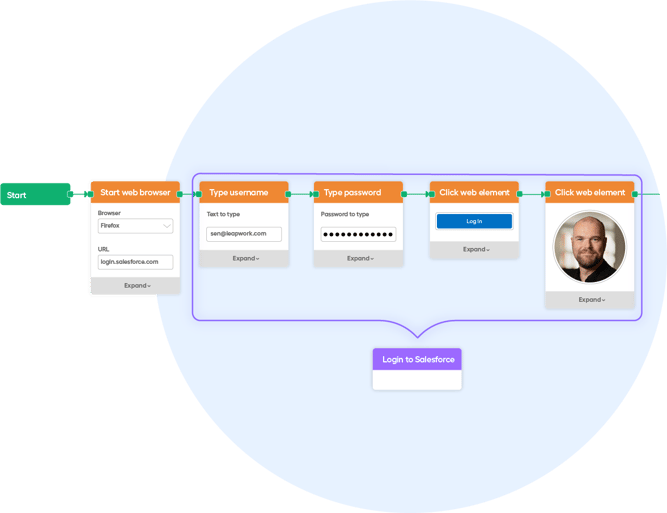What is Scriptless Test Automation?
Experiencing error-prone software, downtime, a loss of revenue, and a negative perception of your brand? Then you might want to know more about scriptless test automation. This article explains what it is, as well as how to automate Selenium with Leapwork.
Skip ahead to:
What is scriptless test automation?
The benefits of no-code test automation for QA
Scriptless test automation with Leapwork
Selenium automation with Leapwork
The automation of QA testing is mostly done by programmers coding scripts—significant parts of the testing process might be performed automatically, but automation requires manual effort in order to create initial testing scripts.
The belief that code-based testing is better limits the effective use of QA resources and prevents scaling. It also results in a waste of resources.
Codeless test automation has been identified as the next focus area for Agile and DevOps, but maintaining scripts is its most challenging aspect. That’s due to the lack of people who can write and maintain those scripts.
What is scriptless test automation?
So what is ‘scriptless’, ‘codeless’, or ‘no-code’ test automation? Essentially, it’s a method of automating tests without developers writing coded scripts. It does not involve scripting.
With scriptless test automation, testers are only required to indicate the testing steps instead of having to write actual code.
That means that the interaction between testers and the code is minimized and more professionals in an organization can create test cases and flows.
The benefits of no-code test automation for QA
Automating testing processes accelerates the coding of test scripts and prevents QA bottlenecks by working parallel with the development process.
Because test case design, validation, and execution are automated, you can scale up while keeping your tests robust. The amount of interaction between testers and code is reduced.
No-code test automation helps to close the skills gap by allowing business users and testers to test without undergoing a major upskilling process. Using a no-code approach also allows testers to concentrate on finding new and innovative ways to automate.
Scriptless test automation with Leapwork
According to the Capgemini World Quality Report 2021-22, ‘an automation-first approach in software quality delivery should now be the norm across all QA activities.’
Codeless automation involves enabling true automation collaboration across an organization. Why do you want to do that? To gain momentum, coverage, meaningful quality, overview and insight.
Ideally, automation is created, maintained and driven as a collaborative effort between technical and non-technical people. With today’s conventional tools, that’s not possible.
That’s where Leapwork comes in.
Whereas a low-code approach still requires coders, Leapwork’s visual automation creates a common language for collaboration. It democratizes automation and makes it possible for people without programming skills to contribute to automated testing.

Related reading: How no-code test automation closes the skills gap in software development
Selenium automation with Leapwork
Test automation tools are usually based on frameworks like Selenium, but automating with Selenium can be difficult.
Leapwork uses Selenium under the hood—making the experience of automating testing entirely codeless. This relieves headaches for your software testing team with no-code test automation making it far easier to use.
Find out more about scriptless/no-code test automation in our webinar on codeless test automation. You’ll see a live demo of no-code tests, and get expert tips on low-maintenance automation design.

